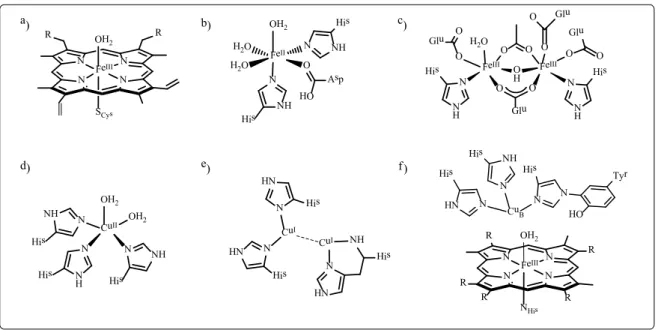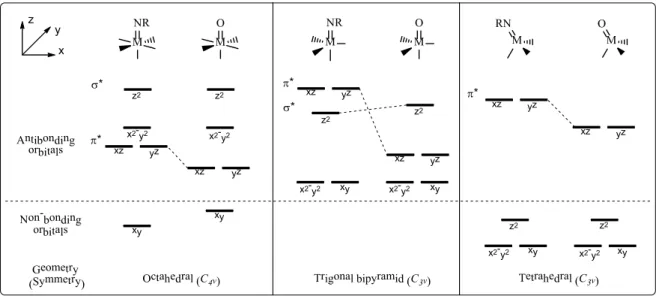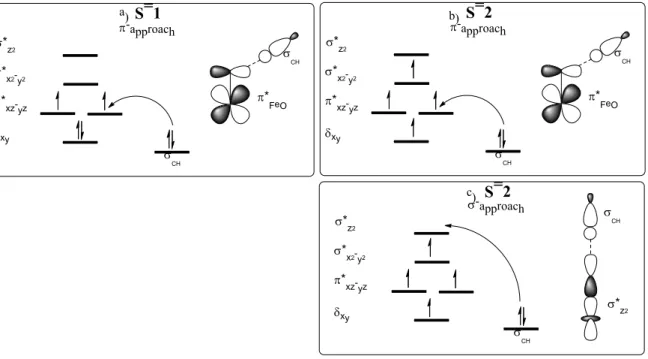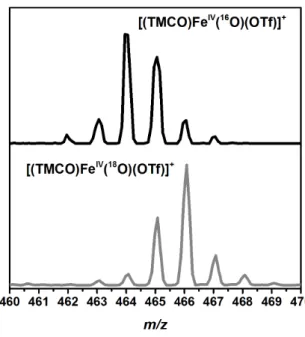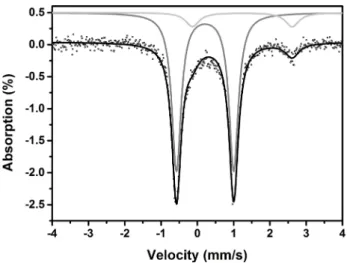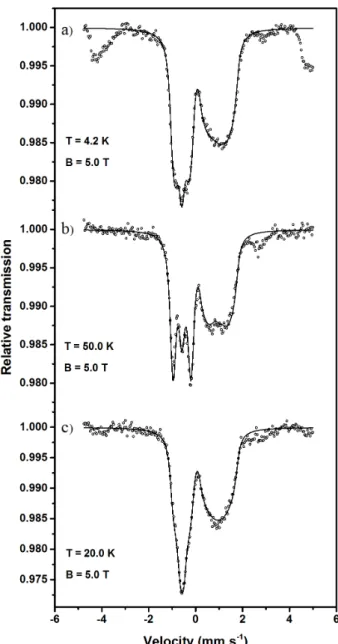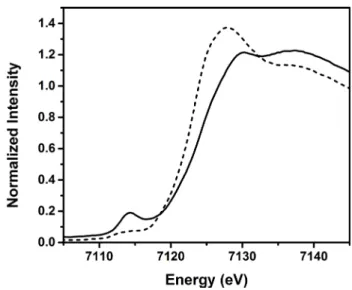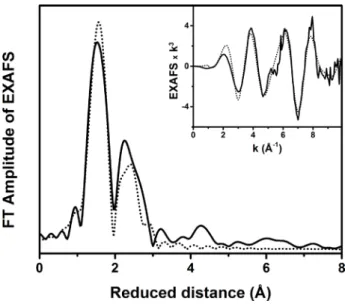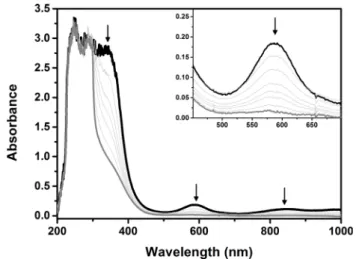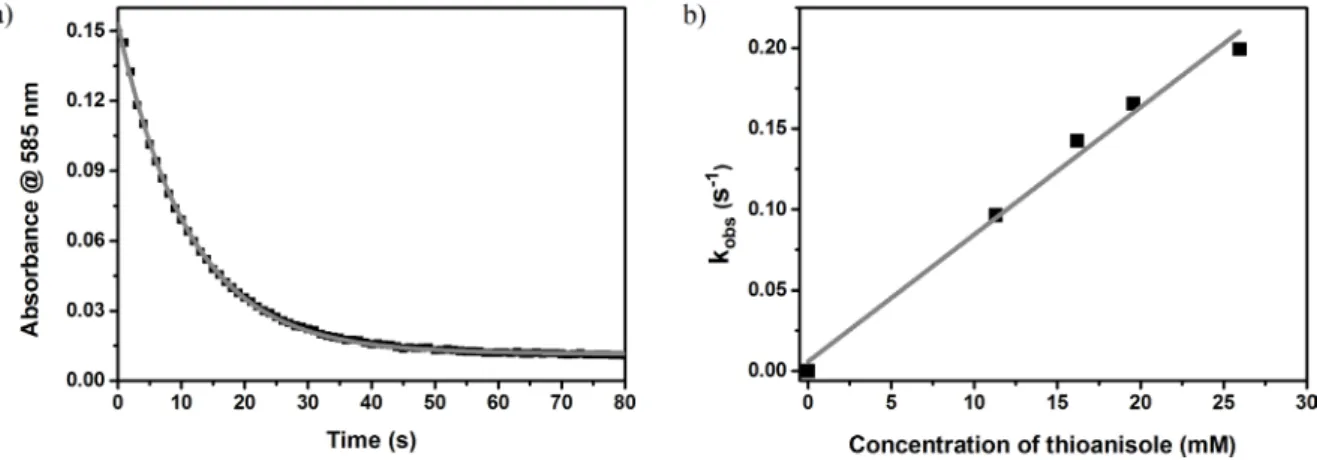Bioinspired oxidation reactions involving mono- and poly-nuclear transition metal complexes: hydrogen atom abstraction and group
transfer reactions
Dissertation
zur Erlangung des akademischen Grades doctor rerum naturalium
(Dr. rer. nat.) im Fach Chemie eingereicht an der
Mathematisch-Naturwissenschaftlichen Fakultät der Humboldt-Universität zu Berlin
von
M. Sc. Inés Monte Pérez
Präsidentin der Humboldt-Universität zu Berlin Prof. Dr.-Ing. Dr. Sabine Kunst
Dekan der Mathematisch-Naturwissenschaftlichen Fakultät Prof. Dr. Elmar Kulke
___________________________________________________________________________
Gutachter/innen:
1. Prof. Dr. Kallol Ray 2. Prof. Dr. Christian Limberg
Tag der mündlichen Prüfung:21.03.2017
II
III Abstract
High-valent metal-oxo, -peroxo and -nitrene cores of late transition metals have been proposed as reactive intermediates in transformations, like the activation of C−H bonds in hydrocarbons and the reduction of dioxygen, that are both technologically attractive and fundamental for the functioning of biological systems. The isolation and characterization of such intermediates, despite being challenging, can provide valuable information about the mechanisms of the reactions performed and can help in the design of improved catalysts. In this Thesis, we have worked with three different kinds of intermediates, namely iron-oxo, cobalt-peroxo and copper- nitrenes, with the aim of examining the effect that small changes in the ligand system, the participating metal centers or the nitrene sources, have on the behavior of a given reactive system.
In our work with non-haem oxoiron(IV) complexes we found that, by placing the iron center in a weaker ligand-field environment - via the insertion of oxygen donors in the ligand system - the reactivity of the high-valent intermediate can be increased. Such increase in reactivity was assigned to a combination of factors such as the greater accessibility of the S = 2 state and the reduction of the steric hindrance around the iron-oxo core. An effect of the asymmetry of the ligand on the reactivity was also detected.
In our work with a hexanuclear cobalt complex, we could assign both nucleophilic and electrophilic character to a cobalt-peroxo intermediate formed in solution from the reaction of the hexanuclear cobalt complex with dioxygen. Interestingly, we found that the hexanuclear complex can also catalytically reduce dioxygen, in the presence of electron and proton sources, to H2O2 or H2O depending on the temperature. This behavior proved to be in sharp contrast with the reaction performed by a hexanuclear iron complex supported by the same ligand that performs O−O bond formation, thus showing the enormous effect that the metal center has on the reactivity of a system.
Finally, we found that the nitrene source has an enormous impact on the stability and reactivity of terminal copper-nitrenes; via nitrene-source design we could -for the first time- isolate two terminal copper-nitrenes both as free species and as their Lewis acid-adducts. We also determined that the reactivity and the electronic structure of the copper-nitrene adducts are independent of the Lewis acid employed to stabilize them.
Taken together, we show in this work that the reactivity patterns of the high-valent reactive intermediates here studied depend greatly on subtle changes in the ligand system, the metal center and the oxidant employed.
IV
V
Zusammenfassung
Hochvalente Metal-oxo-, -peroxo- und -nitrenzentren später Übergangsmetalle werden als reaktive Intermediate vieler technologisch interessanter und biologischer Transformationsreaktionen wie die Oxidation von Kohlenwasserstoffen, Hydroxylierung, Aminierung, Aziridierung und Sauerstoffreduktion angenommen. Die Isolierung und Charakterisierung solcher Intermediate, wenngleich sie sich schwierig gestaltet, kann wichtige Informationen zum Mechanismus solcher Reaktionen liefern und kann somit zu einer gezielten Optimierung und Herstellung von verbesserten Katalysatoren genutzt werden. In dieser Arbeit wurden drei unterschiedliche Intermediate – Eisenoxo-, Kobaltperoxo- und Kupfernitrenkomplexe – näher untersucht, mit dem Ziel den Einfluss des Ligandsystems bzw. des Zentralmetalls oder der Nitrenquelle auf das Reaktionsverhalten der Systeme zu ergründen.
Im Falle der nicht-Häm Eisen(IV)oxokomplexe konnte gezeigt werden, dass der Austausch eines Stickstoffdonors des Liganden durch einen Sauerstoffdonor zu einer erhöhten Reaktivität des Intermediates führt. Die erhöhte Reaktivität wurde durch eine Kombination mehrerer Faktoren begründet: Zum einen besteht ein erleichterter Zugang des S = 2 Zustands, zum anderen findet eine Reduktion der sterischen Abschirmung des Eisenoxo-Kerns statt. Zudem konnte gezeigt werden, dass die Asymmetrie des Liganden eine Erhöhung der Reaktivität zur Folge hat.
Bei der Umsetzung eines hexanuklearen Kobaltsystems mit molekularem Sauerstoff konnte ein Kobaltperoxointermediat in Lösung detektiert werden, welches sowohl nukleophilen als auch elektrophilen Charakter aufweist. Ebenso konnte gezeigt werden, dass der hexanukleare Komplex in der Lage ist Disauerstoff abhängig von der Temperatur und in Anwesenheit einer Elektronen- und Protonenquelle katalytisch entweder zu H2O2 oder H2O zu reduzieren. Dies steht im starken Kontrast zu der Reaktivät, die für den entsprechenden hexanuklearen Eisenkomplex berichtet wurde. Dieser ist in der Lage an O–O-Bindungsknüpfungsreaktionen teilzunehmen, was den großen Effekt des Zentralmetalls auf die Reaktivität demonstriert.
Abschließend konnte durch die Untersuchung der Kupfernitrene gezeigt werden, dass die eingesetzte Nitrenquelle einen großen Effekt auf Stabilität und Reaktivität der gebildeten terminalen Kupfernitrenverbindung hat. Erstmalig gelang es, durch ein gezieltes Design der Nitrenquelle zwei terminale Kupfernitrene, sowohl als freie Spezies als auch als das Lewis-Säure-Addukt, zu isolieren. Es konnte ebenfalls gezeigt werden, dass die Reaktivität und die elektronische Struktur der Kupfernitrenkerne unabhängig von der zur Stabilisierung eingesetzten Lewis-Säure sind.
Es konnte somit in dieser Arbeit gezeigt werden, dass die Reaktivität der hier untersuchten hoch-valenten reaktiven Intermediate maßgeblich abhängig vom Ligandsystem, dem Zentralmetall und dem verwendeten Oxidanten sind.
VI
VII
This work was developed under the supervision of Prof. Dr. Kallol Ray from October 2012 to September 2016 at the Institut für Chemie of the Mathematisch-Naturwissenschaftliche Fakultät I at the Humboldt-Universität zu Berlin.
VIII
IX
Acknowledgments
Firstly, I would like to express my sincere gratitude to Prof. Dr. Kallol Ray for the continuous support of my PhD studies, for his motivation and immense knowledge. He provided an enthusiastic guidance throughout the past four years that, though hard sometimes, allowed me to grow both professionally and personally.
I am indebted to Prof. Dr. Christian Limberg for the valuable suggestions and discussions during the group seminars and for being the second reviewer of my Thesis. I’m also thankful to him for allowing me to participate in the activities of his group and for giving me access to the instruments and equipment much necessary for the development of my work.
I would like to thank the members of the Ray group that accompanied me throughout the demanding process of learning to do independent research. My special thanks go to Xenia Engelmann, who has helped me the most during the last years with insightful discussions, amusing coffee-breaks and providing always a solidary and friendly hand; I am also thankful to her for the studies on oxoiron complexes that I present in this Thesis and that we developed together. Thanks to the former members of the group: Dr. Subrata Kundu, Dr. Florian Pfaff and Dr. Florian Heims, from whom I learned a lot and to whom I will always be grateful. I am particularly grateful to Dr.
Subrata Kundu, whose research served as a starting point for most of the work that I present in this Thesis, to Dr. Florian Pfaff for the rRaman and Möβbauer measurements, to Vikoria Steck for the initial work on copper-nitrenes with substituted nitrene sources and to Sarah-Luise Abram for the starting studies on the copper-mesityl azide system. Thank you also to the current group members:
Katrin Warm, Anirban Chandra and Jennifer Deutscher, for the nice atmosphere in the laboratory and for their comradeship.
I am thankful to the members of the groups of Prof. Dr. Christian Limberg and Dr. Matthias Schwalbe for providing a nice working atmosphere. Especially, I am grateful to Dr. Fabian Schax for the XRD measurement, to Dr. Iweta Pryjomska-Ray for the support and advice from the beginning of my time here and for her help with ESI-MS and GC-MS measurements and to Dr.
Corinna Matlachowski, Siu Ting-Li and Marie-Louise Wind for the fruitful discussions and their continuous help. I am especially thankful to Malu for reading and correcting this Thesis.
I am grateful to the scientific, technical and administrative staff of the Institut für Chemie of the Humboldt Universiät zu Berlin, particularly, to Mrs.Ursula Kätel for the elemental analysis and to the NMR department for measuring my samples.
X
I would like to acknowledge the contributions of the following groups and individuals to the development of this Thesis. They kindly provided their facilities and expertise in different techniques that allowed us to make interesting chemistry.
- I am thankful to Dr. Eckhard Bill at the Max-Plank-Institut für Chemische Energiekonversion (Germany) for his support with EPR and Magnetic Möβbauer measurements.
- Thanks to Erik Farquhar at the Brookhaven National Laboratory (USA) for the X-Ray absorption studies.
- I am grateful to Prof. Dr. Marcel Swart from the Universitat de Girona (Spain), who performed DFT calculations on our systems.
- I am also thankful to Prof. Nicolai Lehnert and Casey van Stappen from the University of Michigan (USA) for their work on the challenging characterization of the hexanuclear cobalt complex.
- I am grateful also to Prof. Jason England from the Nanyang Technological University (Singapore) for the NMR measurements.
- I would like to thank also Dr. Alexander Schnegg from the Helmholtz Zentrum Berlin (Germany) for the access to the EPR under their supervision.
- I am also grateful to Prof. Dr. Peter Hildebrandt and Dr. Uwe Kuhlmann in the Technische- Universität Berlin (Germany) for the access to the rRaman.
My most sincere thanks go to the BIG-NSE and UniCat for the economic and academic support, and for providing an open and inclusive learning atmosphere. Especially, I want to thank Dr. Lonjaret (JP) for his kindness and support throughout this process.
Finally, I want to thank my family and friends for their never-ending love and support.
Thank you to my parents and my brother for always being there for me, no matter how far away we are. Thank you to Andrés, my husband, for standing with me in the good and the bad times and for being the best life companion one could ever have.
XI
XII
XIII Contents
Chapter 1: General Introduction ... 1
1.1 O2 activation ... 3
1.2. Relevant enzymatic mechanisms and their intermediates ... 5
1.2.1 Cytochrome P450 monooxygenases ... 5
1.2.2 Taurine dioxygenase... 7
1.2.3. Soluble methane monooxygenase ... 8
1.2.4 Cytochrome c oxidase ... 9
1.3. Synthetic model systems ... 10
1.4 Bonding of metal-oxo and metal-nitrene complexes... 12
1.5. Stabilizing late transition metal-oxo and metal-nitrene complexes... 14
1.6. The aim of this work ... 16
1.7. References ... 17
Chapter 2: Trapping and Characterization of a New FeIV=O Intermediate with Enhanced Reactivity due to Innovative Ligand Design ... 21
2.1. Introduction ... 23
2.2. Results and discussion ... 30
2.2.1 Synthesis of the TMCO ligand ... 30
2.2.2 Synthesis and characterization of Fe-1 ... 33
2.2.3 Generation and characterization of Fe-2 ... 35
2.2.4 Oxidative reactivity of Fe-2 ... 43
2.2.5 Comparison with the TMCN system ... 52
2.3 Conclusions ... 56
2.4 References ... 57
Chapter 3: Reactivity Studies of a Hexanuclear Cobalt Complex Supported on a Stannoxane Core 63 3.1. Introduction ... 65
3.2. Results and discussion ... 71
3.2.1 Characterization of Co-L6 ... 71
3.2.2 Nucleophilic oxidative reactivity of Co-1 ... 77
3.2.3 Electrophilic oxidative reactivity of Co-1 ... 80
3.2.4 Dioxygen reduction catalyzed by Co-L6 ... 83
3.3 Conclusions ... 94
3.4 References ... 94
XIV
Chapter 4: Systematic Studies involving the Trapping and Characterization of Elusive Copper-
Nitrenes Using Different Nitrene-Sources and Lewis Acids ... 99
4.1. Introduction ... 101
4.2. Results and Discussion ... 105
4.2.1 Variation of the Lewis acid bound to the copper-tosylnitrene intermediate ... 105
4.2.2 Variation of the nitrene source employed for stabilizing the copper-nitrene intermediates ... 116
4.3 Conclusions ... 136
4.4 References ... 137
Chapter 5: Conclusions and outlook ... 141
Chapter 6: Equipment and experimental work ... 147
6.1 General techniques and chemicals employed ... 148
6.2 Analytical techniques ... 148
6.2.1. Elemental analysis ... 148
6.2.2. Nuclear magnetic resonance spectroscopy (NMR) ... 148
6.2.3. Mass spectrometry ... 149
6.2.4. Infrared spectroscopy (IR) ... 149
6.2.5. UV-vis absorption spectroscopy ... 149
6.2.6. Gas chromatography coupled to mass spectrometry (GC-MS) ... 150
6.2.7. X-Ray diffraction crystallography (XRD)... 150
6.2.8. Electron paramagnetic resonance spectroscopy (EPR) ... 151
6.2.9. Resonance Raman (rR) spectroscopy ... 151
6.2.10. Möβbauer spectroscopy ... 152
6.2.11. X-ray absorption spectroscopy (XAS) ... 153
6.2.12. Magnetic Circular Dichroism (MCD) ... 154
6.2.13. Superconducting quantum interference device (SQUID) susceptibility measurements ... 154
6.2.14. Density Functional Theory (DFT) calculations ... 155
6.3. Syntheses of compounds and generation of intermediates ... 156
6.3.1. Synthesis of the ligands TMCO and TMCO-d ... 156
6.3.2. Synthesis of the complexes Fe-1, Fe-1d and 57Fe-1 ... 159
6.3.3. Synthesis of the oxidants sPhIO and sPhI18O ... 160
6.3.4. Generation of the intermediates Fe-2, Fe-2d, Fe-2-18O and 57Fe-2 ... 161
6.3.5. Synthesis of the ligand TMCN and TMCN-d ... 162
XV
6.3.6. Synthesis of the complexes Fe-3 and Fe-3d ... 164
6.3.7. Generation of the intermediates Fe-4 and Fe-4d ... 165
6.3.8. Synthesis of the ligand L6 ... 165
6.3.9. Synthesis of the complex Co-L6 ... 166
6.3.10. Generation of the intermediate Co-1 ... 166
6.3.11. Synthesis of the Complex [(AN)Cu]BF4 ... 166
6.3.12. Synthesis of the oxidants sPhINTs and sPhI15NTs ... 167
6.3.13. Generation of the intermediates Cu-1-M and Cu-1-Y-15N ... 168
6.3.14. Synthesis of the oxidants sPhINArCF3 and sPhI15NArCF3 ... 169
6.3.15. Synthesis of the oxidants sPhINArNO2 and sPhI15NArNO2 ... 170
6.3.16. Generation of the intermediate Cu-2 ... 171
6.3.17. Generation of the intermediates Cu-2-Sc and Cu-2-Sc-15N ... 171
6.3.18. Generation of the intermediate Cu-3 ... 172
6.3.19. Generation of the intermediates Cu-3-M and Cu-3-15N ... 172
6.3.20. Synthesis of the oxidant Mes-N3 ... 173
6.3.21. Generation of the intermediate Cu-4-Sc ... 173
6.4. References ... 174
Appendices ... 179
A1. Crystallographic data ... 180
A2. Lists of abbreviations ... 181
A3. Declaration ... 185
A4. Publications and presentations ... 187
XVI
Chapter 1:
General Introduction
2
The activation of small molecules such as N2, O2, H2, CO2 or CH4 has been in the spotlight of chemical research and technology development for some decades; the interest in activating such molecules stems from the context of the current environmental crisis and the demand for cleaner chemical processes and energy sources.[1] Some small molecules, like H2 and O2, have the potential to be used as clean energy alternatives to fossil fuels in devices such as fuel cells. The activation of other molecules, like N2 and O2, would allow the fixation of their elements in atom-efficient ways and may lead to the generation of value-added chemicals like ammonia and oxidized hydrocarbons, some of which are essential for sustaining life on our planet. The activation of a third group of molecules that includes CO2 and NOx, which act as pollutants and greenhouse gases, would facilitate their removal from the atmosphere, thus significantly improving environmental conditions.
Finally, the activation of CH4 is also of particular relevance in the context of efficient natural energy resource use. Methane is the main component in natural gas, but is also one of the most prevalent greenhouse gases, with a comparative impact on climate change 25 times greater than CO2 over a 100-year period. Its characteristics give methane two contrasting facets: on the one hand, with the depletion of oil reserves, methane has the potential to become the most important hydrocarbon feedstock for the generation of chemicals;[2] on the other hand, given its environmental impact, a large amount of methane released in crude oil extraction is being flared because of the lack of technology to properly transport the gas to marketplaces.[3,4] The activation of methane, for example by oxidation to methanol, would prevent the need to flare it by making it easier to transport as a liquid, and would provide a starting point for the generation of value-added chemicals, thus promoting the exploitation of methane resources in a cleaner and more efficient way.[5] The activation of methane is, however, not an easy process and is still not employed to its full potential in the chemical industry. This is because methane is highly stable, since it has four strong and localized C−H bonds with high bond-dissociation energies (104 kcal mol-1) and lacks any low- energy empty orbitals or high-energy filled molecular orbitals.[2] The activation of the C−H bonds of methane and other alkanes into useful functional groups has therefore become an active and expanding field of research that could revolutionize the chemical industry and greatly impact the environment.[2,6]
Transition metals play an important role in the activation of small molecules by providing low-barrier reaction pathways for their transformations. A number of examples of synthetic C−H bond activation reactions promoted by transition metal centers have been reported in the past decades.[7,8] So far, the most efficient known catalyst for methane activation is the platinum-based Periana catalyst; however, its potential industrial applications are limited by the cost of platinum – a
3
non-abundant metal – as well as by the extreme reaction conditions required.[9] Nature, on the other hand, uses cheap non-toxic transition metals (like Fe, Cu and Mn) at the active sites of metalloenzymes, for the oxidation and selective functionalization of strong C−H bonds in atom- economical transformations under mild pressure and temperature conditions.[10] Interestingly, in natural systems the controlled oxidation of organic substrates is coupled with the activation of yet another small molecule: dioxygen. Thus, in a great variety of metalloenzymes, the activation of oxygen – the cheapest and most naturally abundant oxidant – precedes the activation of strong C−H bonds (including those of methane) and their conversion to their oxidized counterparts.
1.1 O2 activation
The use of molecular oxygen as a terminal oxidant, as employed in biological systems, is desirable because O2 is both naturally abundant and inexpensive. Nonetheless, it is not straightforward to use, as evidenced by the fact that oxygen coexists with a number of combustibles under ambient conditions without oxidizing them. From a thermodynamic point of view, dioxygen is potentially reactive; however, the direct oxidation of organic molecules with O2 is kinetically prevented. The reason for this lies in the electronic configuration of the molecules involved.
Oxygen has a triplet ground state (S = 1) (Figure 1.1) unlike the organic compounds that have diamagnetic (S = 0) ground state configurations. The addition of O2 to organic compounds is spin- forbidden, since the starting compounds have a total spin S = 1 whereas the oxidation products are diamagnetic with S = 0. In order to overcome this prohibition, O2 can react with species that contain
2s 2s
ss ss* sp sp*
p p*
2p 2p
Energy
O O2 O
Figure 1.1: Molecular orbitals of the O2 molecule.
4
unpaired electrons or are able to undergo single-electron transfer reactions, such as free radicals (as in combustion), photochemical-induced excited triplet states or transition metals. Nature’s preferred strategy is the use of transition metals.[1]
N
N N
N
R R
FeIII OH2
SCys
FeII OH2 H2O
O H2O
CuB N
N HN N
NH
N His
His
His
HO Tyr N
NH His
N NH
His
Asp HO
a) b) c)
FeIII FeIII O
O
H2O O
O O
Glu
O O O
O Glu Glu
N NH
His Glu
N NH His
d)
CuII N N N
OH2 OH2
NH NH
NH
His His His
e)
CuI HN
HN
HN N N
N
His His
NH His CuI
f)
N
N N
R N R
R
R
R FeIII
NHis OH2 H
O
O
Figure 1.2: Structures of representative active sites employed in biology for oxygen activation.
a) Mononuclear haem iron unit in Cytochrome P450; b) mononuclear non-haem iron core in Taurine dioxygenase; c) dinuclear non-haem site in soluble Methane monooxygenase; d) mononuclear copper site in Copper amine oxidase; e)dinuclear copper site in particulate Methane monooxygenase and f) heterodinuclear
Cu/Fe center in Cytochrome c oxidase.
Metalloenzymes employ a wide variety of metallic sites to activate O2, such as mononuclear haem and non-haem iron units, mononuclear copper centers, homodinuclear iron and copper centers, as well as heterodinuclear iron/copper centers (Figure 1.2).[11,12] In these active sites, O2 is activated in a controlled manner to generate a variety of reactive intermediates that lead to the selective oxidation of suitable substrates by avoiding any over-oxidation of products as well as the dangerous oxidation of the protein subunit surrounding the active metal site. A common mechanism for the activation of O2 in metalloenzymes has been proposed (Scheme 1.1).[13] In this mechanism, the oxygen first binds to the metal center to generate a metal-superoxo species, converting the kinetically inert triplet ground state of O2 to a more reactive doublet state in O2●-. The metal- superoxo intermediate can further gain an electron to generate a metal-peroxo species and subsequently a proton to generate a metal-hydroperoxo core or directly abstract a hydrogen atom to form the metal-hydroperoxo intermediate. Finally, this species can undergo either O−O bond homo- or heterolysis to generate a highly reactive metal-oxo intermediate (Scheme 1.1 a). In dinuclear
5
systems, the unified mechanism is similar but the intermediates formed are the superoxo-, peroxo- and the high-valent metal-oxo species shown in Scheme 1.1 b. Although Scheme 1.1 presents a general unified method for the biological activation of dioxygen, the catalytic cycle of each enzyme is unique and dependent on its own function and structure.
Mn++ O2 M(n+1)+ O2- superoxo
M(n+1)+ O22- e- peroxo
M(n+1)+ O2H hydroperoxo
H H+
heterolysis homolysis
M(n+3)+ O M(n+2)+ O
+ OH- + OH oxo
Mn+ Mn+ + O2 M(n+1)+ O2- superoxo
Mn+ M(n+1)+ O22-
peroxo
M(n+1)+ M(n+2)+ M(n+2)+
O
O oxo a)
b)
Scheme 1.1: Proposed unified mechanisms for the activation of O2 at a) mononuclear and b) dinuclear enzymatic active sites.
1.2. Relevant enzymatic mechanisms and their intermediates
Enzymes are the perfect catalysts. They are able to perform reactions – that are otherwise too energy-demanding – in mild conditions via the generation and reaction of the above-mentioned reactive intermediates. Metalloenzymes provide access to these species in a controlled fashion, thus regulating the reaction’s mechanism and selectivity. In the following sections, detailed descriptions of the catalytic cycles of four relevant metalloenzymes are provided, with special emphasis on the nature of their key reactive intermediates.
1.2.1 Cytochrome P450 monooxygenases
Cytochrome P450s (P450s) are a family of haem-containing enzymes ubiquitous to most biochemical systems. They play a vital role in the synthesis of biomolecules and the metabolism of exogenous substances like drugs and toxicants by catalyzing reactions such as aliphatic C−H bond hydroxylation, olefin epoxidation and the oxidation of aromatic compounds and aldehydes.[14] The most common P450s are monooxygenases, as they activate O2 and incorporate one oxygen atom into a substrate while the other oxygen atom is reduced to water.
The accepted catalytic cycle of P450 monooxygenases is presented in Scheme 1.2.[1,14,15]
The active site of this family of enzymes contains an iron-protoporphyrin IX complex, where the
6
iron is coordinated to the sulfur atom from a cysteine residue in one of the axial positions (Figure 1.2 a); in the resting state, the sixth coordination site of the Fe(III) is occupied by a molecule of water. When the organic substrate binds within the active site, the water molecule is displaced and a penta-coordinated Fe(III) complex is formed, which makes the iron center susceptible to reduction to a high-spin Fe(II) compound. In this reduced state, the iron center is able to bind O2, generating a low-spin Fe(III)-superoxo complex. This species is subsequently reduced and protonated to generate an Fe(II)-hydroperoxo intermediate, known as Compound 0 (Cpd-0).
The protonation of Cpd-0 results in heterolytic O−O bond cleavage, the liberation of water, and the generation of a high-valent oxoiron(IV) haem cation radical species known as Compound I[16] (Cpd- I, Scheme 1.2 center). Cpd-I is believed to be the most reactive intermediate of the cycle and able to abstract a hydrogen atom from the substrate to generate an Fe(IV)-hydroxo complex (Compound II) and a carbon-centered radical.[17] Following the “rebound” mechanism,[18-20] the substrate radical is hydroxylated, and a molecule of water replaces the hydroxylated product bound to the iron center, thereby regenerating the complex in its resting state.
FeIII O
SCys
H H
FeIII SCys
RH FeII
O
SCys
R H
FeII SCys RH
FeIII SCys
RH O O
FeIII SCys RH O HO FeIV
SCys O RH
RH
e-
e-,H+ ROH
H+ H2O
O2
Cpd-0 Cpd-I
N
N N
N
R R
FeIV O
SCys Cpd-I FeIV
SCys O R
Cpd-II H
H2O
Scheme 1.2: Catalytic cycle of P450 enzymes and structure of Compound I (Cpd-I).
7 1.2.2 Taurine dioxygenase
Taurine Dioxygenase (TauD) is a member of the large and diverse family of the α-ketoglutarate (α-KG)-dependent dioxygenases. Notably, dioxygenases – in contrast to monooxygenases – catalyze the oxidation of a substrate without reducing one of the oxygen atoms from O2 into a water molecule; instead, both oxygen atoms are incorporated into a substrate or a co- substrate.[21] The α-KG-dependent dioxygenases often employ in their active sites a monomeric non-haem Fe(II) center, facially coordinated by the array of two histidines and one aspartate or glutamate (Figure 1.2 b). The iron center activates O2 to effectuate the decarboxylation of the α-KG, acting as a co-substrate, and the two-electron oxidation of the substrate, which is typically a hydroxylation but can also be a desaturation or a cyclization reaction. The biological functions of this family of enzymes include the degradation of xenobiotics and the biosynthesis of connective tissue, antibiotics and secondary metabolites, as well as the reparation of methylated DNA and RNA and the control of oxygen and iron homeostasis.[22] TauD, in particular, plays a fundamental role in the metabolism of cysteine, an important amino acid that is toxic in high concentrations, by regulating its concentration in the body.[21] TauD’s catalytic cycle is commonly regarded as representative of those of the α-KG dependent dioxygenases since the first reactive intermediate trapped in this family of enzymes was the intermediate-J from the TauD enzyme.[23]
The accepted catalytic mechanism of TauD is shown in Scheme 1.3.[21,22,24] In the resting state the Fe(II) center is coordinated to the 2-His/1-Carboxylate ligand motif that links the iron center to the enzyme, and the three remaining coordination sites are occupied by water molecules.
Upon coordination of the co-substrate, α-KG, two water molecules are released. The third water molecule is liberated after the substrate, taurine, docks in the active site, leaving the Fe(II) center penta-coordinated. The O2 molecule then binds to the iron center, generating an Fe(III)-superoxo intermediate, which presumably attacks the α-keto position of the α−KG, forming a structure whose subsequent decarboxylation leads to the formation of a high-valent S = 2 oxoiron(IV) species known as Intermediate-J[23,24] (Scheme 1.3 center). Intermediate-J is believed to be responsible for hydrogen atom abstraction from the substrate, followed by O-rebound to yield the hydroxylated product. Further departure of the succinate, together with the coordination of water molecules, returns the iron center to the resting state.
8
FeII OH2
NHis
H2O NHis
OAsp H2O
FeII OH2
NHis
O NHis
OAsp O O
-OOC
FeII
NHis
O NHis
OAsp O O
-OOC
+H3N SO3-
FeIII O
NHis
O NHis
OAsp O O
-OOC
+H3N SO3- O
FeIV O
NHis
O NHis
OAsp O
-OOC
+H3N SO3-
CO2 FeIII
OH
NHis
O NHis
OAsp O
-OOC
+H3N SO3- FeII
HO
NHis
O NHis
OAsp O
-OOC
+H3N SO3-
a-ketoglutarate
Taurine
O2 3H2O
Products
FeIV O
NHis
O NHis
OAsp O
-OOC
Intermediate-J
Scheme 1.3: Catalytic cycle of Taurine Dioxygenase (TauD) and structure of the Intermediate-J.
1.2.3. Soluble methane monooxygenase
Enzymes capable of transforming methane into methanol are of particular interest since, as discussed before, this reaction is one of the most promising catalytic processes for the development of cleaner energies and efficient use of carbon sources.[5] Two metalloenzymes are known that perform this reaction, namely, the membrane-bound particulate methane monooxygenase (pMMO),[25] and the soluble methane monooxygenase (sMMO).[26] Methane monooxygenases (MMOs) are present in all methanotrophs as the main enzymes of their metabolic pathways. The most common of all MMOs are pMMOs, which have a dinuclear copper core in their active sites (Figure 1.2 e),[25] whereas sMMOs are formed under copper-limited conditions and rely on a carboxylate-bridged dinuclear iron center (Figure 1.2 c) to perform the selective hydroxylation of methane to methanol.
In the last few decades, sMMOs have been intensively investigated given their ease of isolation, in comparison to pMMOs, which are found embedded in membranes; the catalytic cycle of sMMOs is therefore better understood and is shown in Scheme 1.4.[26-29] The resting state of the
9
enzyme is the oxidized di-iron(III) cluster that is further reduced by two electrons to yield the reduced di-iron(II) species; this reactive species binds O2 to generate a peroxo-di-iron(III) intermediate. The further cleavage of the O−O bond yields the reactive species MMO-Q (Scheme 1.4 center) that contains a high-valent bis(µ-oxo)diiron(IV) core. The MMO-Q intermediate is recognized as the key oxidizing species of the sMMO catalytic cycle. Spectroscopic studies suggest that it possesses a unique [FeIV2(µ-O)2]4+ diamond core where the iron centers are in a high-spin configuration (S = 2) and strongly exchange-coupled.[28] The formulation of the exact structure of the MMO-Q intermediate is still debated;[26,29] however, the schematic structure presented in Scheme 1.4 is the most widely accepted, where a high-valent oxodiron(IV) diamond core can be observed.
FeIII FeIII
O O
Glu O O
FeIV FeIV
O O
Glu O O FeIII FeIII
O O
Glu O O H2
H
FeII FeII
O O
Glu OH2
O2
CH4 CH3OH
H2O H2O 2H+, 2e-
FeIV FeIV
O O
Glu O O
MMO-Q
Scheme 1.4: Overview of the catalytic cycle of the soluble methane monooxygenase (sMMO).
1.2.4 Cytochrome c oxidase
Besides the controlled activation of C−H bonds, metalloenzymes perform other vital processes that involve the activation of O2, like the four-electron reduction of dioxygen to water.
Redox reactions such as this one are performed by enzymes known as oxidases. Cytochrome c oxidase[30] (CcO) is a vital enzyme in the respiratory pathway of aerobic organisms. It is capable of reducing dioxygen as a part of the cellular process to generate energy in the form of ATP molecules. The protein CcO contains two iron-porphyrin units (haem a and haem a3) and two mononuclear copper sites (CuA and CuB). The haem a and CuA cores act as electron transfer sites,
10
while the haem a3 and CuB form a dinuclear active site that activates dioxygen (Figure 1.2 f).[12,31]
The roles of the different amino acid residues and metals of the active site of CcO are still under discussion[32-34] However, based on the intermediates that have been spectroscopically detected, the catalytic cycle shown in Scheme 1.5 has been proposed.[35] Even when the active site is bimetallic, the reduction of O2 involves intermediates that are very similar to those observed in monometallic enzymes, including the iron-superoxo and the oxoiron(IV) species.
FeII OH2
FeII O2
L
FeIII OOH
L FeIV
O
L FeIII OH
L e-, H+
e-, H+
e-, H+ e-, H+
O2
H2O
H2O
Scheme 1.5: Overview of the catalytic O2 reduction performed in the active site of the Cytochrome c oxidase.
1.3. Synthetic model systems
The previously described enzymes are all distinct and perform unique and specific reactions; nevertheless they all proceed via the same classes of intermediates. A full comprehension of these reactive species -including their generation, structure and reactivity- is necessary to achieve a better understanding of the catalytic enzymatic mechanisms and for the further design of synthetic catalysts capable of performing similar processes. The study of these reactive species in the active sites of metalloenzymes presents multiple challenges related to their location within a complex protein environment, in addition to the difficulty of altering them directly – for example, through variation of their ligand system or metallic cores. The reduced size of synthetic biomimetic models, on the other hand, enables them to be easily isolated and spectroscopically studied. Furthermore, the ligand environments of the models can be modified both sterically and electronically to get more insights into the catalytic mechanisms and structural proprieties of biological systems.[27,36] Models can provide information on unclear enzymatic mechanisms or boost our understanding of known biological intermediates, but they can also deviate from the biological structural resemblance and be employed for the development of better catalysts with potential applications.[36,37]
11
Based on the enzymatic catalytic cycles presented above, it is clear that metal-oxo species play a fundamental role in nature. Given their relevance, vast studies on synthetic metal-oxo complexes have been carried out.[10,35,38-41] Of special interest for this work are mononuclear non- haem oxoiron(IV) complexes. Over 60 synthetic non-haem oxoiron(IV) complexes have been reported in the last 15 years,[10-35,42–54] most of which have been fully characterized, and their reactivities in oxidation reactions have been intensively tested.[10] The most important non-haem oxoiron(IV) models are discussed in detail in Chapter 2. It is important to state that until very recently all the reported non-haem oxoiron(IV) complexes failed to mimic the actual spin state of the enzymatic active sites (S = 2) and were also not successful in activating C−H bonds at the same rates as the natural reactive intermediates. However, in 2015, Que Jr. and coworkers stabilized an oxoiron(IV) complex in a high-spin configuration that activates C−H bonds at rates comparable with those of the Intermediate-J of TauD, which represented a major breakthrough in the field.[47]
Despite the clear scientific interest in synthesizing complexes that closely mimic the active species of biological systems, an attractive feature of the bioinspired modeling is that the chemistry can be taken one step further and new systems can be built beyond the scope of the typical biological choices. Gas phase studies,[55,56] together with theoretical calculations[57] on methane activation processes mediated by different metal-oxo systems, have suggested that metal-oxo cores with metals beyond iron, such as nickel and cobalt, are more reactive towards hydrocarbon functionalization than their oxoiron counterparts due to the weaker metal-oxo bonds in their naked [MO]n+ cores. The search for high-valent metal-oxo cores with later transition metals such as cobalt and nickel has engendered a new working field that includes the search for terminal copper(III)-oxo cores, a structure that has also been proposed as a plausible intermediate in natural and artificial systems, but which has yet to be isolated.[13] The challenges posed by this emerging field are related to the anticipated strong repulsion between the electron-rich oxo ligand and the late transition metal, and the bonding considerations that will be discussed later in this Chapter.
Another attractive field in synthetic bioinorganic chemistry deals with multi-nuclear complexes. Many enzymes choose polynuclear sites to perform important oxidative transformations. Some use dinuclear active sites, like sMMO and CcO, as has already been discussed. Others occupy active centers with higher nuclearity, like nitrogenase, which employs a Fe7MoS9C cofactor to reduce nitrogen to ammonia, or photosystem II, where water oxidation takes place in a Mn4CaO5 cluster. Synthetic polynuclear complexes can reveal information on the importance of cooperativity for the reactivity of these enzymes and their intermediates. This topic
12
will be further addressed in Chapter 3, which will deal with the activation of O2 with a hexanuclear cobalt system.
Finally, the chemistry of the metal-oxo complexes can also be extended to include the isoelectronic metal-nitrene cores (where nitrenes are NR2-). Notably, metal-nitrene species are relevant in synthetic processes as they have been proposed as the active intermediates in C−H bond functionalization for the generation of valuable C−N bonds.[39,58] Furthermore, metal-nitrene species are often more stable than the corresponding metal-oxo species, owing to the additional steric protection provided by the substituent of the –NR2- used. Correspondingly, metal-nitrene units can in some cases provide information about the properties of elusive metal-oxo cores. Of particular importance for this work are the copper-nitrene systems, and the advancements in this field of research are discussed in Chapter 4.
1.4 Bonding of metal-oxo and metal-nitrene complexes
The relevance of the metal-oxo cores as key oxidizing species in a variety of enzymatic catalytic cycles has been evidenced. The importance of this species is, however, not limited to nature; academic and industrial laboratories also rely on metal-mediated oxidative transformations, many of which also proceed through metal-oxo complexes.[59-61] The related terminal metal-nitrene cores have also been proposed as the key reactive intermediates in a number of transition metal- mediated synthetic conversions of C−H to C−N bonds.[39,58] The analysis of the qualitative d orbital splitting patterns of the terminal metal-oxo and metal-nitrene cores facilitates the understanding of the stability and reactivity of these species. Figure 1.3 presents the qualitative splitting patterns that would be expected for metal-oxo and metal-nitrene cores as derived from ligand field theory for different geometries around the metal center.[39]
The ligand field splitting of the d orbitals of metal-oxo complexes in an octahedral geometry (C4v symmetry) is a result of the tetragonal compression associated with the strong M=O bond. The compression along the z-axis, where the oxo ligand is situated, produces a lifting of the degeneracies of the d orbitals, which leads to the energy ordering shown in Figure 1.3. The orbitals 𝑑𝑑𝑧𝑧2 and 𝑑𝑑𝑥𝑥2−𝑦𝑦2, which point to the axes where the ligands are situated, form strong s* antibonding combinations with the s orbitals of the ligands. The orbitals 𝑑𝑑𝑥𝑥𝑧𝑧 and 𝑑𝑑𝑦𝑦𝑧𝑧, on the other hand, are of p* antibonding character as a result of their interaction with the 𝑝𝑝𝑥𝑥 and 𝑝𝑝𝑦𝑦 orbitals of the oxo ligand. Finally, the orbital 𝑑𝑑𝑥𝑥𝑦𝑦 is of a non-bonding nature. As a result of this orbital splitting, in C4v
symmetry, a metal-oxo double bond is only possible for metals with four or fewer d electrons since
13
further occupation of the p* orbitals would result in a loss of the metal-oxo p bonding and the resulting metal-oxo species would be highly unstable.
M O M
O M
NR
M RN
Tetrahedral(C3v) Octahedral(C4v)
z2 z2
x2-y2 xy x2-y2 xy
xz yz
xz yz
xz yz
xz yz
z2 z2
x2-y2 x2-y2
xy xy
p*
p*
s*
z x y
Antibonding orbitals
Non-bonding orbitals
M O M
NR
Trigonalbipyramid(C3v)
xz yz
xz yz
z2 z2
x2-y2 xy x2-y2 xy p*
s*
Geometry (Symmetry)
Figure 1.3: Qualitative ligand field splitting of the d orbitals for metal-oxo and metal-nitrene complexes in C3v
and C4v symmetry.
In the tetragonal bipyramid geometry (TBP), with C3v symmetry, the metal-oxo complexes exhibit a different ligand field d orbital splitting. The 𝑑𝑑𝑧𝑧2 orbital is of s* antibonding nature and is at a significantly higher energy level than the other orbitals. The orbitals 𝑑𝑑𝑥𝑥𝑧𝑧 and 𝑑𝑑𝑦𝑦𝑧𝑧 form a degenerate set of p* antibonding orbitals, while the 𝑑𝑑𝑥𝑥𝑦𝑦 and 𝑑𝑑𝑥𝑥2−𝑦𝑦2 orbitals form a degenerate set of a s* antibonding nature. The relative energy order between these two sets of degenerate orbitals depends on the strength of the equatorial ligand field. Given that in a TBP environment the set of s* degenerate orbitals can accommodate four electrons and the p* degenerate set two electrons without decreasing the metal-oxo bond order, the M=O species should be accessible for metals with a d electron count of six or fewer. Notably, d6 configurations would lead to the destabilizing orbital filling where the 𝑑𝑑𝑥𝑥𝑦𝑦 and 𝑑𝑑𝑥𝑥2−𝑦𝑦2 orbitals are completely full; however, penta-coordinated M=O species with a d6 electron count have been reported.[62,63]
Finally, the ligand field splitting for the metal d orbitals of a metal-oxo complex in a pseudo-tetrahedral geometry, also with C3v geometry, shows a very different orbital energetic order.
Contrary to what was observed for TBP and octahedral geometries, the 𝑑𝑑𝑧𝑧2 orbital is much lower in energy and has a non-bonding nature instead of a s* antibonding character; this can be explained by the fact that the 𝑑𝑑𝑧𝑧2 orbital is not engaged in the metal-oxo bonding. It has also been postulated that
14
the possibility of the 𝑑𝑑𝑧𝑧2 orbital getting hybridized by mixing with the 4s and 4𝑝𝑝z orbitals of the metal, a phenomenon allowed in non-centrosymmetric geometries, lowers its energy and mitigates its antibonding character.[64] Higher d-electron counts of up to eight electrons in low-spin configuration could stabilize metal-oxo complexes in tetrahedral geometry.
The orbital splitting patterns discussed for the metal-oxo systems also apply for the metal- nitrene cores, with small variations. The oxo (O2-) and nitrene (NR2-) ligands are isoelectronic;
however, they differ in their nuclear effective charge (Z*). The nitrene ligand has a smaller Z* than the oxo since it possesses the same number of electrons but fewer protons. The filled p orbitals of the nitrene are therefore higher in energy than those in the oxo, which makes them better energetically matched with the d orbitals of the metal and results in the observed character of the nitrene ligand being a better p donor than the oxo ligand. The better p donor character of the nitrene ligand results in a stronger destabilization of the p* dxz and dyz orbitals of the metal relative to those of the metal-oxo complexes (see Figure 1.3), which alters the qualitative ligand field splitting in the C4v symmetry, giving rise to a 1+3+1 splitting pattern.
The ligand field d orbital splitting patterns can be useful to rationalize the occurrence of transition metals M=X systems (X= O2- or NR2-), especially the metal-oxo ones, which are more common and well-studied.[59] In an octahedral geometry, up to two electrons can fill the non- bonding orbital 𝑑𝑑𝑥𝑥𝑦𝑦 for the complexes to maintain a bond order of three and be stable; hence, oxo- complexes of early transition metals with low electron counts (d ≤ 2) are ubiquitous and unreactive.
With every electron added to the system, the bond order is reduced by 0.5, the metal-oxo bond is activated and the resulting species are more reactive. The M=O bond remains a double bond up to a d electron count of four. However, with d > 4 electrons, the metal-oxo bond is weakened and the stabilization of such species is harder. Hence, as we move right in the periodic table, M=X cores become rarer and more strongly oxidizing. Nature typically selects oxoiron(IV) complexes for oxidizing substrates with strong C−H bonds. Since the Fe(IV) centers have four d-electrons, they form metal-oxo complexes that are right at the balance point between stability and reactivity: they can be generated but they are highly reactive. Indeed, at this balance point between stability and reactivity lies the biggest challenge in the study of reactive intermediates.
1.5. Stabilizing late transition metal-oxo and metal-nitrene complexes
The stabilization of first-row high-valent late transition metal-oxo or -nitrene cores presents difficulties due to the repulsive interactions between the electron-rich terminal oxo or nitrene ligands and the electrons of the metal center, which are related to the above-discussed bonding
15
considerations. Accordingly, given that d4 metals can preserve the double bond character of the M=O core, over 50 synthetic oxoiron(IV) complexes have been stabilized; however, metal-oxo cores with later metals such as cobalt have only been trapped in a couple of cases, and only in the form of Lewis acid adducts.[65,66] The strategy of utilizing external redox-innocent Lewis acids, such as Sc(III) and similar cations, for stabilizing the short-lived intermediates has been employed in the successful trapping of a low-spin (S = 1/2)[65] and an intermediate-spin (S = 3/2)[66] cobalt(IV)-oxo intermediates in the form of [CoIV-O-Sc3+] cores, as well as for the trapping of a Lewis acid adduct of a cationic copper-tosylnitrene species in the form of a [CuII-(NTs•)-Sc] core.[67] These three species are shown in Figure 1.4. It is believed that the effect of the external electron withdrawing group in these systems is related to its interaction with the M=X core, that lowers the electronic repulsion between the metal and the ligand.[68]
N CoIV N
N
N O
O O
O O
Sc(OTf)3
CoIV N
N
N N
O N
N
NN N
N
Sc(OTf)3
[(TMG3tren)CoIV(O)Sc(OTf)3]2+ [(TAML)CoIV(O)Sc(OTf)3]2-
N Cu N
N H
N
Sc(OTf)3 Ts
II
[(AN)CuII(NTs)Sc(OTf)3]+
a) b) c)
Figure 1.4: Non-covalent interactions with external Lewis acids for the stabilization of the otherwise elusive CoIV-oxo and terminal Cu-nitrene species in the complexes a) [(TMG3tren)CoIV(O)-Sc(OTf)3]2+,
b)[(TAML)CoIV(O)-Sc(OTf)3]2- and c) [(AN)CuII(NTs●)-Sc(OTf)3]+ where Ts= tosyl group.
Other important factor that must be considered for the trapping of high-valent reactive intermediates is the design of the ligand that anchors the metal center. The ligands can be chosen to enforce a certain geometry around the metal center; this strategy has been employed by several groups to stabilize high-spin oxoiron(IV) complexes by using bulky tripodal ligands that enforce a trigonal-bipyramidal geometry around the iron center.[49,54,69] The structure and nature of the donor atoms of the ligand can also be chosen to provide a suitable ligand field environment to favor certain electronic configuration on the metal center; for example Que Jr. and coworkers reported the stabilization of the most reactive synthetic high-spin non-haem oxoiron(IV) complex by employing a tripodal ligand with weaker field donors.[47] Additionally, ligands with sites capable of providing non-covalent interactions with the terminal oxo or nitrene ligands have been also designed; the most notorious example is the ligand H3Buea, employed by Borovik and coworkers, which is able to
16
mimic the secondary interactions of the enzyme by hydrogen-bond stabilization of an Fe(III)−hydroxo complex.[54]
A purposeful ligand design is, hence, necessary for the stabilization of highly reactive M=X cores. For systems dealing with late transition metals with high d electron counts, the introduction of electron withdrawing groups that can alter the electronic distribution of the metal-oxo or metal- nitrene cores must also be considered. Other aspects, like the solvent and temperature used for the generation and testing of the M=X species, are also important in achieving the proper balance between stability and reactivity of these species. All of these factors will be considered and discussed in this work, which deals with the generation, trapping and reactivity testing of reactive intermediates.
1.6. The aim of this work
The importance of, and interest in, the isolation and characterization of reactive intermediates such as metal-oxo and metal-nitrene cores with late transition metals has been widely discussed. During my doctoral research, I worked with a series of reactive intermediates with terminal oxo and nitrene ligands. My work is divided into three different projects, according to the metal center and the kind of ligand employed in each case. The aim of these projects was to examine the effect that small changes in the ligand system, the participating metal centers or the nitrene sources, have on the behavior of a given reactive system.
In the first project (Chapter 2), a new oxoiron(IV) complex, namely [(TMCO)FeIV(O)]2+, was synthesized. The ligand TMCO is analogous to the existing TMC ligand but instead of having four nitrogen donors, it has three nitrogen donors and an oxygen donor, which places the iron center in a weaker field environment. The effect that this change has on the stability, electronic structure and reactivity of this set of oxoiron(IV) complexes was thoroughly investigated.
In the second project (Chapter 3), the reactivity of a hexanuclear cobalt system [(L6)Co6II] was studied. It has been reported that [(L6)Co6II] reacts with O2 to generate a peroxo and subsequently an oxo intermediate.[70] The nucleophilic and electrophilic reactivity of the detected intermediates was evaluated. The ability of [(L6)Co6II] to catalytically reduce O2 was also studied, and proved to contrast with the previously reported analogous iron compound [(L6)Fe6II] that performed the O−O bond formation reaction.[71]
Finally, in the third project (Chapter 4), a complete series of terminal copper-nitrenes was studied. The effect that the Lewis acids (M) have on the generation and reactivity of the Lewis-acid
